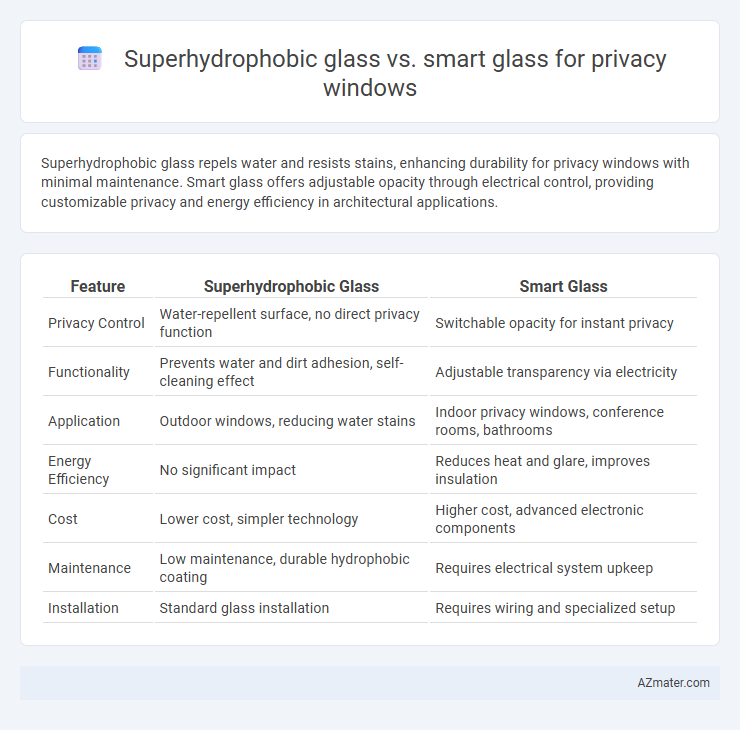Superhydrophobic glass repels water and resists stains, enhancing durability for privacy windows with minimal maintenance. Smart glass offers adjustable opacity through electrical control, providing customizable privacy and energy efficiency in architectural applications.
Table of Comparison
| Feature | Superhydrophobic Glass | Smart Glass |
|---|---|---|
| Privacy Control | Water-repellent surface, no direct privacy function | Switchable opacity for instant privacy |
| Functionality | Prevents water and dirt adhesion, self-cleaning effect | Adjustable transparency via electricity |
| Application | Outdoor windows, reducing water stains | Indoor privacy windows, conference rooms, bathrooms |
| Energy Efficiency | No significant impact | Reduces heat and glare, improves insulation |
| Cost | Lower cost, simpler technology | Higher cost, advanced electronic components |
| Maintenance | Low maintenance, durable hydrophobic coating | Requires electrical system upkeep |
| Installation | Standard glass installation | Requires wiring and specialized setup |
Introduction: Evolving Technologies in Privacy Windows
Superhydrophobic glass and smart glass represent two cutting-edge technologies transforming privacy windows by enhancing functionality while maintaining transparency. Superhydrophobic glass repels water and dirt, enabling self-cleaning properties that preserve clarity without compromising privacy. Smart glass employs electrochromic or thermochromic technologies to dynamically adjust opacity, offering customizable privacy and energy efficiency tailored to user needs.
What is Superhydrophobic Glass?
Superhydrophobic glass features an ultra-water-repellent coating that causes water droplets to bead and roll off, maintaining a clear, stain-free surface ideal for privacy windows exposed to moisture. Unlike smart glass, which adjusts transparency through electrical stimuli to control visibility, superhydrophobic glass ensures long-lasting clarity without electronic components or power consumption. This technology is particularly effective for outdoor privacy applications where water resistance and self-cleaning properties enhance window performance and durability.
Key Features of Superhydrophobic Glass
Superhydrophobic glass features an ultra-water-repellent surface that prevents fogging and enhances visibility, making it ideal for privacy windows exposed to moisture. Its self-cleaning properties reduce maintenance by repelling dirt and water droplets efficiently. Unlike smart glass, which relies on electrical modulation of light transmission, superhydrophobic glass offers passive protection without power consumption.
What is Smart Glass?
Smart glass is an advanced material that changes its light transmission properties when voltage, heat, or light is applied, enabling dynamic control over privacy and transparency in windows. Unlike superhydrophobic glass, which primarily repels water through nano-coatings to prevent fogging and maintain visibility, smart glass offers adjustable opacity or tint, enhancing privacy on demand. Common technologies in smart glass include electrochromic, photochromic, and thermochromic systems, which allow users to switch from clear to frosted states for privacy without sacrificing natural light.
Core Benefits of Smart Glass for Privacy
Smart glass offers dynamic privacy control by allowing users to switch between transparent and opaque states instantly, ensuring adaptable privacy levels without compromising natural light. Its energy-efficient properties reduce heat transfer, enhancing indoor comfort while lowering cooling costs. Unlike superhydrophobic glass, which primarily repels water and reduces cleaning, smart glass directly addresses privacy needs with customizable opacity on demand.
Performance Comparison: Water Repellency vs. Adaptive Transparency
Superhydrophobic glass excels in water repellency by creating a highly water-resistant surface that prevents droplets from adhering, ensuring clear visibility during wet conditions. Smart glass offers adaptive transparency by electronically changing its opacity to control light and privacy levels dynamically, responding to environmental or user inputs. While superhydrophobic glass enhances clarity in humid or rainy environments, smart glass provides versatile privacy control through adjustable translucency, making their performance advantages dependent on specific application needs.
Energy Efficiency: Superhydrophobic vs Smart Glass
Superhydrophobic glass enhances energy efficiency by repelling water and reducing surface contamination, which minimizes cleaning efforts and maintains optimal light transmission for natural illumination. Smart glass actively controls solar heat gain and light transmittance through electrochromic or thermochromic technologies, significantly lowering cooling and heating demands. While superhydrophobic coatings offer passive maintenance benefits, smart glass provides dynamic energy management, making it more effective for comprehensive energy savings in privacy windows.
Installation, Maintenance, and Longevity
Superhydrophobic glass offers easy installation with no electrical components, requiring simple mounting like traditional glass, while smart glass demands professional wiring and integration with control systems. Maintenance for superhydrophobic glass involves routine cleaning to sustain water-repellent properties, whereas smart glass necessitates specialized care to avoid damage to electronic elements. Longevity favors superhydrophobic glass due to its passive nature and resistance to weathering, while smart glass may degrade faster from frequent use of electrical features and potential component failures.
Cost Considerations and Market Availability
Superhydrophobic glass generally incurs higher manufacturing costs due to specialized coatings that repel water and contaminants, limiting its widespread market availability primarily to niche commercial applications. Smart glass, featuring electrochromic or thermochromic technologies, offers scalable pricing that varies with control systems complexity, making it more accessible for residential and commercial privacy window solutions. Market adoption favors smart glass for privacy windows because it balances moderate costs with dynamic opacity control, whereas superhydrophobic glass remains less prevalent due to cost and limited privacy functionality.
Choosing the Right Privacy Window for Your Needs
Superhydrophobic glass repels water and dirt, offering a self-cleaning surface ideal for outdoor privacy windows exposed to harsh weather. Smart glass provides adjustable opacity through electronic control, making it perfect for indoor environments where dynamic privacy and light control are essential. Selecting between these options depends on whether durability in outdoor conditions or flexible, on-demand privacy is your priority.

Infographic: Superhydrophobic glass vs Smart glass for Privacy window
 azmater.com
azmater.com